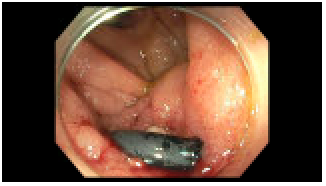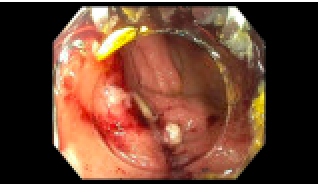Sunday Poster Session
Category: Interventional Endoscopy
P1445 - Cholecystocolonic Fistula; A Rare Late Complication Following EUS Guided GB Drainage
Sunday, October 26, 2025
3:30 PM - 7:00 PM PDT
Location: Exhibit Hall
- AM
Anila Mahesh, MD (she/her/hers)
Geisinger Wyoming Valley Medical Center
Duryea, PA
Presenting Author(s)
Anila Mahesh, MD1, Deepak Kumar, MBBS, MD2, Nihaal Karnik, MD3, Amit Sohagia, MD4, Karla Leschinsky, PA-C4, Abhinav Goyal, MD4, Kishore Kumar, MD4
1Geisinger Wyoming Valley Medical Center, Duryea, PA; 2Northwell Health, Port Jefferson, NY; 3Geisinger Wyoming Valley Medical Center, Wilkes-Barre, PA; 4Geisinger Community Medical Center, Scranton, PA
Introduction: Endoscopic ultrasound-guided gallbladder drainage (EUS-GBD) has emerged as a safe, effective and minimally invasive alternative to surgical cholecystectomy, percutaneous drainage, and endoscopic transpapillary GBD in patients with acute cholecystitis. The invention of the lumen-apposing metal stent (LAMS), and more recently, FDA approval of single-step EUS-guided LAMS delivery systems, have made EUS-GBD simpler and safer. Although this technique has been widely accepted by the interventional endoscopy community, contraindications, potential adverse events, and late complications should be thoroughly discussed prior to the procedure, especially with surgically unfit patients.
Case Description/
Methods: 69 year old man with medical history of metastatic adenocarcinoma of the cecum s/p right hemicolectomy followed by radiation and chemotherapy, history of EUS guided gallbladder (GB) drainage with successful placement of 10mmx 10mm LAMS and an additional 7Fr x 5cm coaxial plastic stent was placed across LAMS into the GB to prevent stent migration, clogging and allow adequate biliary drainage. He now presented with worsening of RUQ and RLQ abdominal pain associated with chills. Imaging findings showed multiple foci of gas within gallbladder with frothy secretion appearance, and some pericholecystic inflammatory fat stranding. EGD and colonoscopy was performed and occlusion of the cholecystoduodenostomy was excluded. The colonoscopy showed erosion of the double pigtail plastic stent from the GB into the colonic lumen. The stent was removed with raptor forcep and fistulous tract was closed with over the scope clip. Follow up CT abdomen with contrast showed no evidence of contrast extravasation and decrease in the amount of gas and fluid within GB lumen. Patient was discharged home on antibiotic therapy.
Discussion: EUS-GBD is a relatively safe procedure, with minimal complications in expert hands. Stent migration, displacement or maldeployment is the most dreaded complication of EUS-GBD. Although there is no formal recommendation on the coaxial pigtail stent placement, many experts prefer an additional barrier to prevent LAMS migration, occlusion and to allow adequate GB drainage. Given lack of evidence offering longterm advantage of coaxial pigtail placement across LAMS and possibility of pigtail erosion into the adjacent viscera particularly when the GB is collapsed, the necessity and timely removal of pigtail should be considered in the future.

Figure: Migrated pigtail stent at the Ileocolic anastomosis with both ends embedded into the wall

Figure: Defect found at the anastomosis due to migrated pigtail stent
Disclosures:
Anila Mahesh indicated no relevant financial relationships.
Deepak Kumar indicated no relevant financial relationships.
Nihaal Karnik indicated no relevant financial relationships.
Amit Sohagia indicated no relevant financial relationships.
Karla Leschinsky indicated no relevant financial relationships.
Abhinav Goyal indicated no relevant financial relationships.
Kishore Kumar indicated no relevant financial relationships.
Anila Mahesh, MD1, Deepak Kumar, MBBS, MD2, Nihaal Karnik, MD3, Amit Sohagia, MD4, Karla Leschinsky, PA-C4, Abhinav Goyal, MD4, Kishore Kumar, MD4. P1445 - Cholecystocolonic Fistula; A Rare Late Complication Following EUS Guided GB Drainage, ACG 2025 Annual Scientific Meeting Abstracts. Phoenix, AZ: American College of Gastroenterology.
1Geisinger Wyoming Valley Medical Center, Duryea, PA; 2Northwell Health, Port Jefferson, NY; 3Geisinger Wyoming Valley Medical Center, Wilkes-Barre, PA; 4Geisinger Community Medical Center, Scranton, PA
Introduction: Endoscopic ultrasound-guided gallbladder drainage (EUS-GBD) has emerged as a safe, effective and minimally invasive alternative to surgical cholecystectomy, percutaneous drainage, and endoscopic transpapillary GBD in patients with acute cholecystitis. The invention of the lumen-apposing metal stent (LAMS), and more recently, FDA approval of single-step EUS-guided LAMS delivery systems, have made EUS-GBD simpler and safer. Although this technique has been widely accepted by the interventional endoscopy community, contraindications, potential adverse events, and late complications should be thoroughly discussed prior to the procedure, especially with surgically unfit patients.
Case Description/
Methods: 69 year old man with medical history of metastatic adenocarcinoma of the cecum s/p right hemicolectomy followed by radiation and chemotherapy, history of EUS guided gallbladder (GB) drainage with successful placement of 10mmx 10mm LAMS and an additional 7Fr x 5cm coaxial plastic stent was placed across LAMS into the GB to prevent stent migration, clogging and allow adequate biliary drainage. He now presented with worsening of RUQ and RLQ abdominal pain associated with chills. Imaging findings showed multiple foci of gas within gallbladder with frothy secretion appearance, and some pericholecystic inflammatory fat stranding. EGD and colonoscopy was performed and occlusion of the cholecystoduodenostomy was excluded. The colonoscopy showed erosion of the double pigtail plastic stent from the GB into the colonic lumen. The stent was removed with raptor forcep and fistulous tract was closed with over the scope clip. Follow up CT abdomen with contrast showed no evidence of contrast extravasation and decrease in the amount of gas and fluid within GB lumen. Patient was discharged home on antibiotic therapy.
Discussion: EUS-GBD is a relatively safe procedure, with minimal complications in expert hands. Stent migration, displacement or maldeployment is the most dreaded complication of EUS-GBD. Although there is no formal recommendation on the coaxial pigtail stent placement, many experts prefer an additional barrier to prevent LAMS migration, occlusion and to allow adequate GB drainage. Given lack of evidence offering longterm advantage of coaxial pigtail placement across LAMS and possibility of pigtail erosion into the adjacent viscera particularly when the GB is collapsed, the necessity and timely removal of pigtail should be considered in the future.

Figure: Migrated pigtail stent at the Ileocolic anastomosis with both ends embedded into the wall

Figure: Defect found at the anastomosis due to migrated pigtail stent
Disclosures:
Anila Mahesh indicated no relevant financial relationships.
Deepak Kumar indicated no relevant financial relationships.
Nihaal Karnik indicated no relevant financial relationships.
Amit Sohagia indicated no relevant financial relationships.
Karla Leschinsky indicated no relevant financial relationships.
Abhinav Goyal indicated no relevant financial relationships.
Kishore Kumar indicated no relevant financial relationships.
Anila Mahesh, MD1, Deepak Kumar, MBBS, MD2, Nihaal Karnik, MD3, Amit Sohagia, MD4, Karla Leschinsky, PA-C4, Abhinav Goyal, MD4, Kishore Kumar, MD4. P1445 - Cholecystocolonic Fistula; A Rare Late Complication Following EUS Guided GB Drainage, ACG 2025 Annual Scientific Meeting Abstracts. Phoenix, AZ: American College of Gastroenterology.
